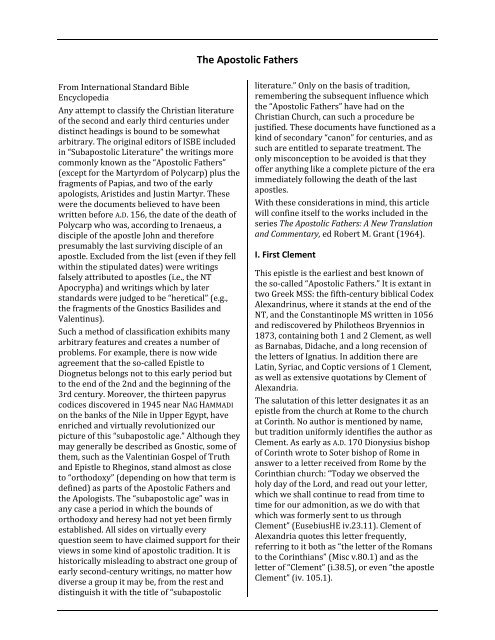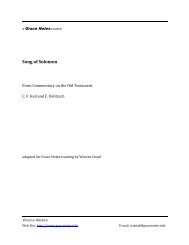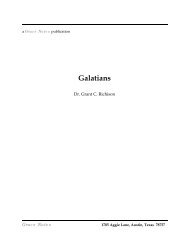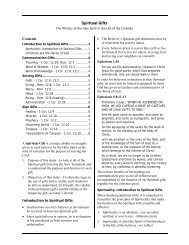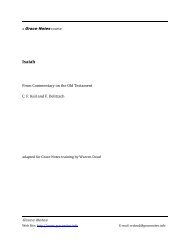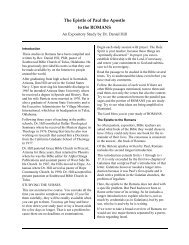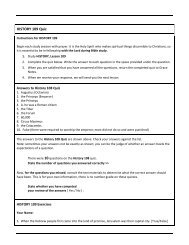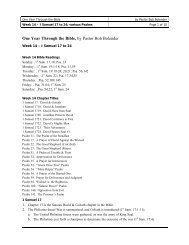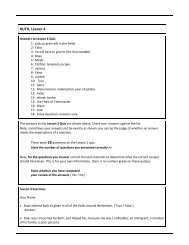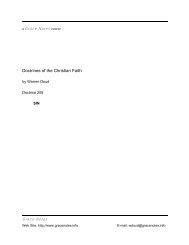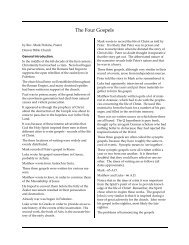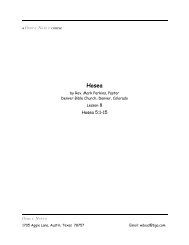Create successful ePaper yourself
Turn your PDF publications into a flip-book with our unique Google optimized e-Paper software.
<strong>The</strong> <strong>Apostolic</strong> <strong>Fathers</strong>From International Standard BibleEncyclopediaAny attempt to classify the Christian literatureof the second and early third centuries underdistinct headings is bound to be somewhatarbitrary. <strong>The</strong> original editors of ISBE includedin “Subapostolic Literature” the writings morecommonly known as the “<strong>Apostolic</strong> <strong>Fathers</strong>”(except for the Martyrdom of Polycarp) plus thefragments of Papias, and two of the earlyapologists, Aristides and Justin Martyr. <strong>The</strong>sewere the documents believed to have beenwritten before A.D. 156, the date of the death ofPolycarp who was, according to Irenaeus, adisciple of the apostle John and thereforepresumably the last surviving disciple of anapostle. Excluded from the list (even if they fellwithin the stipulated dates) were writingsfalsely attributed to apostles (i.e., the NTApocrypha) and writings which by laterstandards were judged to be “heretical” (e.g.,the fragments of the Gnostics Basilides andValentinus).Such a method of classification exhibits manyarbitrary features and creates a number ofproblems. For example, there is now wideagreement that the so-called Epistle toDiognetus belongs not to this early period butto the end of the 2nd and the beginning of the3rd century. Moreover, the thirteen papyruscodices discovered in 1945 near NAG HAMMADIon the banks of the Nile in Upper Egypt, haveenriched and virtually revolutionized ourpicture of this “subapostolic age.” Although theymay generally be described as Gnostic, some ofthem, such as the Valentinian Gospel of Truthand Epistle to Rheginos, stand almost as closeto “orthodoxy” (depending on how that term isdefined) as parts of the <strong>Apostolic</strong> <strong>Fathers</strong> andthe Apologists. <strong>The</strong> “subapostolic age” was inany case a period in which the bounds oforthodoxy and heresy had not yet been firmlyestablished. All sides on virtually everyquestion seem to have claimed support for theirviews in some kind of apostolic tradition. It ishistorically misleading to abstract one group ofearly second-century writings, no matter howdiverse a group it may be, from the rest anddistinguish it with the title of “subapostolicliterature.” Only on the basis of tradition,remembering the subsequent influence whichthe “<strong>Apostolic</strong> <strong>Fathers</strong>” have had on theChristian Church, can such a procedure bejustified. <strong>The</strong>se documents have functioned as akind of secondary “canon” for centuries, and assuch are entitled to separate treatment. <strong>The</strong>only misconception to be avoided is that theyoffer anything like a complete picture of the eraimmediately following the death of the lastapostles.With these considerations in mind, this articlewill confine itself to the works included in theseries <strong>The</strong> <strong>Apostolic</strong> <strong>Fathers</strong>: A New Translationand Commentary, ed Robert M. Grant (1964).I. First ClementThis epistle is the earliest and best known ofthe so-called “<strong>Apostolic</strong> <strong>Fathers</strong>.” It is extant intwo Greek MSS: the fifth-century biblical CodexAlexandrinus, where it stands at the end of theNT, and the Constantinople MS written in 1056and rediscovered by Philotheos Bryennios in1873, containing both 1 and 2 Clement, as wellas Barnabas, Didache, and a long recension ofthe letters of Ignatius. In addition there areLatin, Syriac, and Coptic versions of 1 Clement,as well as extensive quotations by Clement ofAlexandria.<strong>The</strong> salutation of this letter designates it as anepistle from the church at Rome to the churchat Corinth. No author is mentioned by name,but tradition uniformly identifies the author asClement. As early as A.D. 170 Dionysius bishopof Corinth wrote to Soter bishop of Rome inanswer to a letter received from Rome by theCorinthian church: “Today we observed theholy day of the Lord, and read out your letter,which we shall continue to read from time totime for our admonition, as we do with thatwhich was formerly sent to us throughClement” (EusebiusHE iv.23.11). Clement ofAlexandria quotes this letter frequently,referring to it both as “the letter of the Romansto the Corinthians” (Misc v.80.1) and as theletter of “Clement” (i.38.5), or even “the apostleClement” (iv. 105.1).
<strong>Apostolic</strong> <strong>Fathers</strong> 2This Clement of Rome is probably to beidentified with the Clement whom Eusebiusmentions as the third bishop of Rome afterPeter (HE iii.4.9; iii.15.1f). Eusebius’assumption that the Roman church at this earlyperiod was ruled by a single bishop is in alllikelihood an anachronism, even though it wasbelieved already by Irenaeus near the end ofthe 2nd cent (Adv. haer. iii.3). Much earlier,when Ignatius wrote his letter to the Romanchurch, the monarchical bishop isconspicuously absent, while 1 Clement itselfspeaks consistently in terms of a body ofpresbyters rather than a single ruling bishop.Clement was therefore most likely one of thechief presbyters in the Roman church near theend of the 1st cent and wrote his epistle onbehalf of the congregation (cf. EusebiusHEiii.38.1). In the Shepherd of Hermas (Vis 2:4:3)a Clement is mentioned whose duty it was,presumably in the church of Rome, to sendmessages to other cities, and it is possible thatthe same individual is in view.Two other identifications are more speculative:the ancient one of Origen and Eusebius that thisClement is also Paul’s co-worker mentioned inPhil. 4:3, and the modern one that he is thesame as, or belonged to the household of, theconsul Titus Flavius Clemens who was put todeath about A.D. 95 for disloyalty to the godsand pro-Jewish tendencies (Dio Cassius Histlxvii. 14). <strong>The</strong>se are no more than guesses.Essentially 1 Clement is not the product of anidentifiable “great personality,” but a letterfrom one important church to another inresponse to a particular crisis.<strong>The</strong> situation in the Corinthian church issketched in the first three chapters. Chs. 4–36consist of a general discourse on the Christianvirtues (with the Corinthian problem in view).Chs. 37–61 bring the argument to bear on theimmediate crisis. Chs. 62–65 function as asummary and final exhortation from the Romanchurch.<strong>The</strong> author begins by apologizing for thecongregation’s delay in addressing itself to thepredicament of its sister church. He refersvaguely to “misfortunes and calamities” inRome which have hindered this ministry ofexhortation (1:1). We have no way of knowingwhat these troubles were, but possibly thereference is to provocations against Christianslate in the reign of the Emperor Domitian (A.D.81–96). <strong>The</strong> threat in Corinth, however, wasfrom within, an “abominable and unholyschism” (1:1) in which there had been arebellion against those in authority in thechurch (3:1–4). <strong>The</strong> description becomes moreexplicit later on when the author states that “inspite of their good service you have removedsome from the ministry which they fulfilledblamelessly” (44:6). He contrasts the presentsedition with an idealized past whenCorinthians were obedient to their leaders andwholly at peace among themselves (1:2–2:8).<strong>The</strong> reader of the NT will think that thedivisions Paul faced at Corinth have beenoverlooked, but Clement later qualifies thissimplistic picture by admitting that when “theblessed Paul the Apostle” wrote his epistle,“even then you had made yourselves partisans”(47:3). But in those days they had at leastaligned themselves with apostles (cf. 1 Cor.1:12), “men of high reputation,” while now theyhad overturned all authority, so that “onaccount of one or two persons the old and wellestablishedchurch of the Corinthians is inrevolt against the presbyters” (47:6).<strong>The</strong> central section of 1 Clement (4:1–36:6)draws on many sources for examples to combatthe rebellion. Jealousy and envy have broughtabout all kinds of evil in the past, not only in theOT (4:1–13) but in “our own generation” in thetrials which confronted Peter and Paul and theother martyrs (5:1–6:4). But God has alwaysgiven repentance to those who will turn to Him,and according to the “venerable rule of ourtradition” (7:2) has made this repentanceavailable to all through Jesus Christ (7:1–8:5).Thus Clement anticipates the outright appealfor repentance which he will make in ch 57. Hesimilarly extols the virtues of obedience,faithfulness, and hospitality as exemplified insuch OT figures as Abraham, Lot, and Rahab(9:1–12:8). <strong>The</strong>se were evidently the qualitieshe felt to be conspicuously lacking in the rebelsat Corinth. <strong>The</strong> frequent mention of hospitalityin particular suggests that antagonism had beendirected not only toward the Corinthianpresbyters, but perhaps toward emissariesfrom other churches as well, possibly to
<strong>Apostolic</strong> <strong>Fathers</strong> 3messengers from Rome (cf. 63:3; 65:1). What isneeded above all else is humility, and Clementspeaks of many who exemplified this virtue(13:1–19:1), preeminently Christ Himself(16:1–17) and David (18:1–16).<strong>The</strong> keynote of the next subsection is peace andharmony, which Clement illustrates from thenatural creation (19:2–20:12). He reinforces hisappeal to the Corinthians by pointing to thereality of divine judgment and the hope ofresurrection (21:1–28:4). Creation andredemption are inextricably bound together asthe basis on which he presses home hisargument. To support the idea of a futureresurrection he can appeal without muchdistinction to Scripture, to the raising of JesusChrist, to the regularity of nature, and even tothe strange legend of the phoenix bird whorenews himself every fifty years (25:1–5), alegend which is paralleled in several of thepagan “natural histories.” Clement brings to aclose his general discourse on the Christian lifewith an emphasis on holiness as the way to theblessedness that comes from God (29:1–36:6).Here his argument is heavily laced withScripture citations, not only from the OT butfrom the NT as well (esp in ch 36, the Epistle tothe Hebrews). <strong>The</strong> words of 36:6, “Who thenare the enemies?” anticipate the last mainsection of 1 Clement, which turns once more tothe Corinthian situation.Clement adopts military imagery as theframework for his solution to the problemafflicting the church. He reiterates the divinelyestablished order which must govern all things(37:1–43:6) and simultaneously pleads withand warns those who he feels have violated thisorder (44:1–48:6). After a short excursus onlove (49:1–50:7) he renews his appeal forrepentance (51:1–59:2), closing with a longliturgical prayer for harmony (59:3–61:3) and asummary of his argument (62:1–65:2). <strong>The</strong>epistle is carried from Rome to Corinth by“faithful and prudent men, who have livedamong us without blame from youth to old age,and they shall be witnesses between you andus” (63:3). <strong>The</strong>se three messengers are namedin 65:1 with the request that they be allowedquickly to return to Rome, hopefully with newsof reconciliation.1 Clement has considerable historicalimportance as a witness to the authorityexercised by the church of Rome over a sisterchurch near the end of the 1st century. Suchauthority is not surprising in view of the city ofRome’s relation to Corinth as a Roman colony,and in any case it should not be forgotten thattwo decades later Ignatius bishop of Antiochdoes not hesitate to instruct the churches ofAsia Minor. <strong>The</strong>re is therefore no reason toassume that the authority reflected in 1Clement belonged to the Roman church in anyexclusive way.II. Second Clement<strong>The</strong> designation of Clement’s epistle as “first” isreally a misnomer, for there is no authentic“second” letter from him to any church. <strong>The</strong>document known in tradition as 2 Clement isnot an epistle but an anonymous sermon ofuncertain date. Doubt was expressed about itsauthenticity as early as Eusebius (HE iii.38.4). Itgenerally circulated with 1 Clement in the laterChurch, and is extant in the same two Greekmanuscripts and Syriac version as the otherwriting, though it is not found in the Latin orCoptic versions. Codex Alexandrinus breaks offafter ch 12 so that the complete Greek text wasunknown until the Bryennios discovery of theConstantinople manuscript in 1873. This findmade it clear that the document was indeed asermon, for a specific occasion of publicworship is presupposed. <strong>The</strong> hearers areexhorted to “pay attention” both “now” and“when we have gone home,” and to “try to comehere more frequently” (17:3; cf. 19:1).<strong>The</strong> traditional association with 1 Clementsuggests that it was written in Rome, though itsnon-epistolary character weakens Harnack’stheory that it is the lost letter of Bishop Soter tothe Corinthian church. Certain similarities withthe Shepherd of Hermas (e.g., 2Clem 8:6) tendto confirm Roman origin. <strong>The</strong> use of materialotherwise more familiar to us in Gnosticwritings suggests that 2 Clement comes from atime and place in which orthodox and Gnosticalike drew on a common stock of traditions. In12:2–6 the author takes a saying now known tous from the Nag Hammadi Gospel of ThomasLogion 22 and (with no trace of polemic)
<strong>Apostolic</strong> <strong>Fathers</strong> 4attaches to it a wholly orthodox interpretation(much as the Gnostics took apostolic traditionsand without hesitation interpreted them inGnostic fashion). R. M. Grant feels that such apractice points to the time around A.D. 140when such Gnostic teachers as Marcion andValentinus were active in Rome without beingimmediately rejected as heretics. This ispossible, though there is every likelihood thatthis kind of fluidity between “orthodox” and“Gnostic” traditions existed in many times andplaces in the 2nd century.This ancient Christian sermon begins with areflection on the salvation which God hasgranted to the gentile hearers (1:1–4:5). <strong>The</strong>ymust not take lightly either the salvation itselfor Jesus Christ through whom it has come. Hemust be acknowledged as Lord, along with Godthe Father, not only with words but with deedsas well. <strong>The</strong> preacher appeals to Isa. 54:1 and tocertain sayings of Jesus (cf. Mk. 2:17; Lk. 19:10)to make his point that those who were lost arenow saved (2:1–7). It is perhaps significant foran understanding of authority in the secondcenturyChurch that the author appeals toScripture and tradition, and to the OT and “theGospel” (8:5; cf. 2:4) in much the same way. Heconfronts his hearers with the choice betweenthis world and the world to come (5:1–7:6) andcalls them to repentance (8:1–20:5). Thisrepentance is defined as “self-control” (15:1) or“keeping the flesh pure” (8:6). This demand isgrounded in the complicated argument thatChrist (and with Him the Church) was originally“spirit” but became “flesh,” and that in theresurrection the flesh will rise again as it“receives the Spirit” (9:1–5; 14:1–5). Morebroadly and simply, the demand is grounded inthe fear of judgment and hope of the kingdomof God (10:1–12:6; 16:1–3; 17:4–7). Again andagain the preacher renews his call torepentance (8:1f; 13:1; 16:1; 17:1; 19:1), urgingthat if they repent, his hearers will save boththemselves and him their counsellor (15:1; cf.19:1). Like the ancient prophets, he sees hisown fate intertwined with those to whom heministers.III. BarnabasOnce again the title (the Epistle of Barnabas) isa misnomer. Though Clement of Alexandria(e.g., Misc. ii.31.2) and Origen (Contra Celsumi.63) attributed it to Barnabas the companion ofPaul, it is an anonymous work, and Eusebiusclassed it among the “spurious” (HE iii.25.4) orat least “disputed” (vi.13.6; 14.1) bookscirculating in the ancient Church. Yet itsinclusion in the fourth-century Greekmanuscript of the Bible, Codex Sinaiticus,testifies to the great esteem and near-canonicalstatus it enjoyed in some sectors of the Church.In addition it is contained in the Constantinoplemanuscript (see above under First Clement),and in a family of nine Greek manuscripts inwhich Barn 5:7ff is abruptly joined toPolycarp’s Epistle to the Philippians (after 9:2)without a break of any kind. <strong>The</strong>re is also aLatin version, in somewhat abridged form, ofthe first seventeen chapters of Barnabas, aswell as a few Syriac fragments and a number ofquotations by Clement of Alexandria.<strong>The</strong> date of this work cannot be establishedwith any certainty. A statement in 16:4indicates that the Jerusalem temple is in ruins,thus supporting a date between A.D. 70 and 135,but attempts to be more specific are onlyconjectures. <strong>The</strong> reference in 4:4 to the tenkingdoms of Dnl. 7:24 is simply traditionalapocalyptic language and should probably notto be made the basis for any conclusions aboutthe epistle’s date.Though it cannot be proved that Barnabas thecompanion of Paul did not write this book,neither the range of possible dates nor thenature of the document itself makes thetradition that he did very plausible. <strong>The</strong> authoris apparently writing to Gentiles who have beensaved out of darkness and idolatry (14:5–8;16:7), and he claims to write as one of theirown (1:8; 4:6). <strong>The</strong> most obvious affinities ofBarnabas are with Alexandrian Christianity, asevidenced on the one side by similarities in itsOT exegesis with Philo, and on the other by theacquaintance with Barnabas shown by Clementand Origen. Barnabas is more likely the work ofa gentile Christian of Alexandria in the early2nd cent than of the Jewish Christian fromCyprus mentioned in the book of Acts.
<strong>Apostolic</strong> <strong>Fathers</strong> 5<strong>The</strong> introduction (1:1–2:3) is rather generaland gives only a slight indication of what is tofollow. <strong>The</strong> author presents himself as onewhose task it is to impart perfect knowledge tohis readers (1:5), not as a teacher (which heapparently is), but as a father to the children heloves. This knowledge has to do with the past,the present, and the future (1:7; cf. 5:3). <strong>The</strong>knowledge about the future turns out to beconventional eschatological teaching (e.g., ch4); the knowledge of past and present, whichcomprises most of the epistle, turns out to be aseries of allegorical interpretations of the OT.In the ancient prophetic tradition, the authormakes it clear that God does not desireceremonial fasts and sacrifices, but justice andmercy (2:4–3:6). <strong>The</strong> readers are called on tobe ready for the eschatological crisis and not tobe lured into the false security that deceivedthe Jews under the old covenant (4:1–14). Heunderscores the greatness of the Christiancalling by a discussion of the work of Christ,who suffered to prepare a new people and tobring to completion the sins of the old Israel. Heillustrates many aspects of Jesus’ career byquotations and allegorical interpretations of OTpassages (5:1–8:7). Especially elaborate is hisexegesis of Gen. 1:26, 28 and Ex. 33:1, 3 (6:8–19), of the ritual of the Day of Atonement (7:3–11) and of the red heifer ritual of Nu. 19:1–10(8:1–7). <strong>The</strong>n he offers “spiritual”interpretations of such Jewish institutions ascircumcision and the various Mosaic food laws(9:1–10:12). His procedure is to reinterpretceremonial rules as moral and ethicalexhortations. Even though he employs theseinterpretative principles in the framework of apolemic against the Judaism of his day, theauthor of Barnabas had ample precedent for hissometimes fanciful exegesis within Judaismitself (notably Philo and the Letter of Aristeas).Turning his attention to what is distinctlyChristian, “Barnabas” finds many subtleintimations in the OT of the water of baptism,the wood and the shape of the cross, and eventhe name and person of Jesus Himself (11:1–12:11). Here Barnabas exhibits several of thesame interpretative traditions which show upin more detail in the writings of Justin Martyr.<strong>The</strong> heart of the Epistle of Barnabas is thecontrast between the old covenant and the new,with the assertion that God’s true covenantbelongs not to the Jews but to the Christians(13:1–14:9). Correspondingly the ancientsabbath has given way to the Christian “eighthday,” or Sunday, in which Jesus rose from thedead (15:1–9), just as the physical temple inJerusalem has been replaced by the spiritualtemple, the Christian community where Godhas made his dwelling (16:1–10). Chapter 17reads like a conclusion; though there is more hecould write about present and future (cf. 1:7;5:3), it is “hidden in parables” and he judgesthat what he has said is sufficient (17:2).<strong>The</strong>re is thus a definite break at the end of ch17 and in fact the Latin version ends at thispoint. But the Greek manuscripts make a newbeginning with the words, “But let us move onto other knowledge and teaching” (18:1). Thisbegins the famous “Two Ways” section ofBarnabas (18:1–21:9), which is paralleled inDid 1:1–6:2. <strong>The</strong> way of light (ch 19) is underthe rule of God through his angels, while theway of darkness (ch 20) belongs to the angelsof Satan (18:1f). This “Two Ways” teaching is byno means profound or “hidden in parables,” butsounds more like elementary instruction fornew converts (which is exactly how it functionsin the Didache). Older commentators argued forliterary dependence of Barnabas on theDidache or of the Didache on Barnabas, but themore recent tendency has been to favor thedependence of both on a common primitivesource. <strong>The</strong>re are, for example, close parallelsbetween the “Two Ways” tradition and theQumrân Manual of Discipline (1QS 3:18ff). It issurprising to find in such an anti-Jewishdocument as Barnabas a section like this inwhich there is little or nothing that isdistinctively Christian, but in which all that issaid can function appropriately in either aChristian or a Jewish setting. <strong>The</strong> mostplausible explanation is that Barnabas comesfrom a gentile Christian community in whichthe basic instruction given to new convertsfrom idolatry and paganism necessarily focusedas much on general moral principles and thingswhich Christianity inherited from Judaism as itdid on the distinctively new Christian messageof the cross. New converts needed to be taught
<strong>Apostolic</strong> <strong>Fathers</strong> 6to love each other and give alms, and to shunidolatry, murder, lies, and witchcraft. Nothingcould be assumed. <strong>The</strong>re is some evidence that“Barnabas” is at times alluding to this moralcatechism even in the earlier parts of his epistle(e.g., 1:4; 2:9; 4:1, 10; 5:4), and chs 18–21 givethe impression that the author (or someoneelse) has simply appended the full text of hissource for the sake of completeness. Certainlythe Latin tradition witnesses to the fact thatBarnabas circulated without this material aswell as with it. But in any case the author orfinal editor has attached a summary whichdraws together chs 1–17 and 18–20 and servesas the conclusion to both (ch 21). <strong>The</strong> very firstverse of this concluding statement makes itclear that “Barnabas” has made use of theprimitive “Two Ways” material in written form(21:1). Like the NT writers, the author knowsthat his readers are never too mature to bereminded of what they have been taught atconversion.IV. Didache<strong>The</strong> longer title of this work, “<strong>The</strong> Teaching ofthe Lord, through the Twelve Apostles, to theGentitles,” gives a clue to its nature. It seems tobe a work conceived against the background ofMt. 28:18–20, purporting to give the content ofthat which the twelve apostles taught to the“Gentiles” or “nations” of the things which Jesusthe Lord had commanded. It therefore stands ina tradition somewhat different from the onewhich sees Paul as the apostle to the Gentilespar excellence and the Twelve as missionariesto the Jews (cf., e.g., Gal. 2:9); instead theTwelve, representing the whole Church, aresent to the whole world, and indeed especiallyto the Gentiles. Shorter variations of this title(e.g., Teaching [or Teachings] of the Apostles)are cited by several patristic writers (e.g.,EusebiusHE iii.25.4; Athanasius Festal Letter39; the ninth-century Stichometry ofNicephorus), but there is no way to be sure thatthey are identical to the work now known bythis name.This work really came to light for the first timein the Constantinople MS discovered byBryennios. As a result of the publication of thefull text of the Didache in 1883, the “canon” ofthe <strong>Apostolic</strong> <strong>Fathers</strong> was enlarged by one. Itthen became possible to go back and see thatthe Didache in Greek was actually to be found(in a somewhat revised form) in book vii of thefourth-century Egyptian <strong>Apostolic</strong>Constitutions. In addition there are fragmentsin Greek (Oxyrhynchus Papyrus 1782), Coptic,and Ethiopic, and a complete Georgian version.For the “Two Ways” section there is (besidesthe witness of Barn 18–20) a Latin version (theDoctrina) the fourth-century <strong>Apostolic</strong> ChurchOrder, and three other manuals of the 4th centor later. <strong>The</strong>re is no way of being sure that theConstantinople MS represents the “original”Didache nor even what the term “original”exactly means in such a context. We are notdealing here simply with textual variants as wedo when studying the NT, but with a developingtradition, and our various witnesses to theDidache merely afford us glimpses of thistradition at various stages. Total agreement isseldom possible as to which forms are primitiveand which are later adaptations. <strong>The</strong>refore it isdifficult to speak about dates, but thecompilation of purportedly apostolic materialunder the name of the apostles as a groupindicates that the apostles are already figures ofthe past. This together with the apparent use ofMatthew’s Gospel tends to suggest a date ofcomposition in the 2nd cent, though manyspecific elements (e.g., the prayers, the “TwoWays,” and the eschatological teaching) maywell go back to the apostolic age and evenperhaps to the early days of the Jerusalemchurch.<strong>The</strong> “Two Ways” section of the Didache comesat the beginning (1:1–6:2) rather than at theend as in Barnabas. <strong>The</strong> “way of life” is found in1:2–4:14 and the “way of death” in 5:1f, with abrief summary in 6:1–3. <strong>The</strong> parallels withBarnabas are rather close, though by no meansverbal. Didache contains an interpolation in its“Two Ways” material, consisting of words ofJesus based on Matthew and Luke and/or anunknown collection of traditional sayings(1:3b–2:1). This section is missing from the“Two Ways” both in Barnabas and in theDoctrina. It has been inserted here as the“teaching” or explanation of the negative formof the Golden Rule found in 1:2. Thus 2:2–7(which does belong to the “Two Ways”)
<strong>Apostolic</strong> <strong>Fathers</strong> 7becomes the second such explanation (2:1), thistime using a traditional list of prohibitionsbased on the Ten Commandments.Didache 3:1–6 is another interpolation into the“Two Ways,” this time designed to warn againstcertain attitudes and practices which lead tothe more serious sins enumerated in ch 2. Ingood rabbinic fashion the author or compiler is“building a fence around the law” (cf. Mish PirkeAboth i.1) by avoiding even that which mightlead to sin. Unlike the NT, however, theDidachist seems to locate the real sin in the actrather than in the heart. <strong>The</strong> attitudes aredangerous because of what they engender, notbecause they indicate a sinful nature already atwork. In his appended conclusion to the “TwoWays” (6:1–3) the editor adds a pragmatictouch to bring the commands within reach ofeveryone: if the readers can bear the whole“yoke of the law” they will be perfect, but if not,they must simply do the best they can (6:2).In 7:1–4 the theme is baptism, with a clearindication that the “Two Ways” material hasfunctioned in the Didache as instructiondesigned for baptismal candidates. Afterreviewing “all these things” the community is to“baptize in the name of the Father and of theSon and of the Holy Spirit” (7:1). This closelyparallels Mt. 28:19f, where “teaching theGentiles” to obey Jesus’ commands is linked tobaptism involving the same trinitarian formula.Ch. 8 deals with fasting and prayer, centeringon a version of the Lord’s Prayer quite similarto that found in Matthew. Here for the first timea doxology is attached to the prayer; thisdoxology is repeated twice in chs 9f, and alongwith a shorter formula (“To thee be gloryforever”) is used to punctuate the eucharisticmeal prayers found in those chapters. <strong>The</strong>seprayers, before (9:1–5) and after (10:1–7) themeal, are traditional and very ancient,exhibiting a number of parallels with Jewishtable prayers, and embodying traces of aprimitive Palestinian Christology whichdescribed Jesus as God’s servant or as the “holyVine of David.”<strong>The</strong> rest of the Didache addresses itself to otherconcerns of the ancient Church in noparticularly logical sequence: the testing oftraveling teachers and prophets to tell the truefrom the false (11:1–12:5); the responsibility ofthe congregation to those who are found to beworthy (13:1–7); the Sunday gatherings forworship (14:1–3, possibly eucharistic again asin chs 9f); the qualifications for resident leaders(bishops and deacons) with an appeal to haverespect for them and to be at peace with oneanother (15:1–4); and finally a chapter ofeschatological instruction, including a call toreadiness and a small apocalypse (not unlikeMt. 24) which sets forth the events leading upto the end of the age and the return of Christ(16:1–8).Thus the Didache as we know it is acompendium of practical teaching on varioussubjects which must have come up in thecourse of the Church’s fulfillment of itscommission to teach the Gentiles. <strong>The</strong> Jewish orJewish Christian origin of much of the materialmakes the Didache (along with Matthew) animportant witness to the fact that segments ofJewish Christianity besides the Apostle Paultook seriously their calling to be a light and ablessing to the nations. Syria is a plausiblelocale for such a community of JewishChristians. Though recensions of the Didache,or parts of it, can be traced to Egypt, Ethiopia,Rome, etc., many scholars have suggested Syriaor Palestine as the setting of the form of thetradition found in the Bryennios MS. <strong>The</strong>parallels with Matthew and the references tobread or wheat gathered from the “mountains”(9:4) point in this direction, but no one reallyknows.V. Ignatius<strong>The</strong> letters of Ignatius, bishop of Antioch at thebeginning of the 2nd cent, are known to us inthree recensions.(1) <strong>The</strong> short recension, accepted today as theauthentic collection of Ignatius’ writings,consists of the seven letters mentioned byEusebius in HE iii.36.5–11: four from Smyrna,to the churches of Ephesus, Magnesia, Tralles,and Rome; and three from Troas (after leavingSmyrna), to the churches of Philadelphia andSmyrna, and to Smyrna’s bishop, Polycarp. <strong>The</strong>ywere said to have been written while Ignatiuswas en route from Syria to Rome to suffermartyrdom (HE iii.36.3f; cf. Ign Rom. 5:1).
<strong>Apostolic</strong> <strong>Fathers</strong> 8(2) <strong>The</strong> long recension consists of thirteenletters in all, in the following order: two fromAntioch — one from a certain Mary ofCassobola (a neighboring town) to Ignatius, andIgnatius’ letter to her in reply; the four fromSmyrna and three from Troas found in the shortrecension; three from Philippi, to Tarsus,Antioch, and Hero (Ignatius’ successor asbishop of Antioch); and one from Italy toPhilippi. In addition there are some extensiveinterpolations in the seven letters from Smyrnaand Troas mentioned by Eusebius. In the earlyMiddle Ages this collection was enlarged stillfurther by two letters to the apostle John, one toMary the mother of Jesus, and one from Mary toIgnatius in return! Even though these latterwere soon rejected as forgeries, the works ofIgnatius continued to be known in the Churchonly in the long recension until the middle ofthe 17th century.(3) <strong>The</strong> Syriac abridgement, discovered by W.Cureton in 1845, is a Syriac version consistingof only three epistles (to the Ephesians, to theRomans, and to Polycarp), similar in form to theshort recension.<strong>The</strong> dominance of the long recension began tobe broken in 1644 when Archbishop JamesUssher published an edition of Ignatius basedon two medieval Latin MSS which, whilecontaining all the letters of the long recension,provided an uninterpolated text of the sevencore epistles known to Eusebius. Soonafterward a Greek MS was found whichconfirmed the existence of the short recension.It contained the epistles of the short recensionin the same uninterpolated form, except forRomans; a martyrological text discovered a fewdecades later supplied this lack with a similarlyshort text of Romans. Since then, as the result ofcareful investigations of <strong>The</strong>odor Zahn, J. B.Lightfoot, and others, scholarship came to apoint of virtual consensus in favor of the shortrecension. Though some for a time defendedthe originality of the Syriac abridgment, theconsensus still stands. In addition to the Greekand Latin witnesses and the Syriac abridgmentmentioned above, there are fragments in Greek,Syriac, and Coptic, and an Armenian version.In his letter to Polycarp, Ignatius states that hewas unable to write to all the churches becausehe was taken on short notice from Troas toNeapolis on the Macedonian coast. He asksPolycarp to write to the churches that lay aheadon his itinerary, so that they might have newsof Ignatius and send messengers or letters tohim (Ign Polyc 8:1). <strong>The</strong> first of these churcheswould be the one at Philippi, and we havePolycarp’s letter to this church, in which hestates clearly that he is sending them “theletters of Ignatius, which were sent to us byhim, and others which we had by us” (PolycPhil. 13:2). Presumably these would includeIgnatius’ letters to Smyrna and to Polycarp aswell as copies of the four letters written fromSmyrna (i.e., all the letters except that to thePhiladelphians, a copy of which may have beensent to Polycarp as well). Thus Polycarp wasthe earliest collector of the Ignatian corpus andthe person chiefly responsible for itspreservation.Without discussing each of Ignatius’ letters indetail, it can be said that they share a commonstructure which enables the reader to knowmore or less what to expect: first there is anelaborate salutation with praise for the churchand its bishop; then often an appeal to live inharmony with the bishop; then usually someattention to the particular heresy threateningthe church; and finally some reference toIgnatius’ own situation and that of the church inSyria.<strong>The</strong> theology and Christology of Ignatius arisesout of a life situation in which three factorswere at work: (1) his sense of impendingmartyrdom, (2) his awareness of the threat ofheresy and schism, and (3) his concern forunity in the churches under the authority of thebishop.(1) <strong>The</strong> factor of martyrdom looms largest inhis letter to the Romans, where his aim is tomake sure that the church at Rome doesnothing to prevent his execution by the Romanauthorities. For him to die as a martyr is to“attain to God” (Ign Rom. 1:2; 2:1; 9:2) or toChrist (5:3), to “become a disciple” (4:2; 5:1, 3)or a true Christian (3:2), to be reborn (6:1) andthus fully to “become a man” (6:2). His death isa sacrifice (2:2; 4:2), sometimes specifically aeucharistic sacrifice. For Ignatius, violent deathmeans participation in the sacrifice of the flesh
<strong>Apostolic</strong> <strong>Fathers</strong> 9and blood of Jesus Christ. To be martyred is toreceive the sacrament of the eucharist in theultimate sense (7:3). He longs to be devouredby wild beasts and ground as wheat so as tobecome the “pure bread of Christ” (4:1). If thebeasts are reluctant, he will entice and compelthem to destroy him (5:2). Such language hasled to a widespread characterization of Ignatiusas morbid and fanatical in his longing for selfannihilation,but two qualifying factors must bekept in mind: first, his language is only anextension and a heightening of similar phrasesused by the apostle Paul (e.g., Phil. 1:23; 2:17;3:10; Col. 1:24; ff); second, he saw his death asvirtually inevitable and so addressed hisconcern to the one church which, for its ownsake, most needed to see Ignatius’ death as avictory and to interpret it in this way to otherChristians and to the world.Ignatius draws freely on Pauline language, anda case can be made that he, like Paul, seeshimself as a decisive figure in the redemptivehistorical plan of God for the world. Though(like Paul) he is the “least” and like an“untimely birth” (Ign Rom. 9:2; cf. 1 Cor. 15:8f),his great journey from East to West is as crucialto him as Paul’s collection journey to Jerusalem(and from there to Rome and possibly Spain)was to the apostle (cf. Paul in Rom. 15:16–33;also 1Clem 5:5–7). Mal. 1:11 seems to standbehind Ignatius’ thinking here as a kind ofhidden Scripture citation: observance of theeucharist in the gentile churches “from furthesteast to furthest west” is the proof that nowGod’s name is “great among the nations” (cf. Did14:3; Justin Martyr Dial 41.2; 117:1). ToIgnatius this eucharistic sacrifice finds supremeexpression in the sacrifice of his own life (IgnRom. 2:2; 7:3).(2) <strong>The</strong> threat of false teaching comes to thesurface especially in his letters to theMagnesians, Trallians, Smyrneans, andPhiladelphians. Heresy is compared to a deadlypoison (Ign Trail. 6). It seems to haveconfronted Ignatius in two forms: a re-Judaizingof the Christian message not unlike the threatwhich Paul faced, and a docetic denial of thereality of Jesus’ human nature. With regard tothe first, Ignatius follows Paul in warning that“if we are still living according to Judaism, weacknowledge that we have not received grace”(Ign Magn 8:1; cf. Ign Philad 6:1). He arguesthat even the ancient prophets were disciples ofJesus Christ in the Spirit (Ign Magn 9:2; cf. 8:2),and that we who stand in their tradition musttherefore observe not the sabbath but theLord’s Day, on which Christ rose from the dead(9:1). Though Ignatius retains and respects theOT, his supreme authority is Jesus Christ whomhe knows first of all not through ancient Jewishprophecies but through the proclaimedmessage of the gospel (Ign Philad 8:2; 9:2).Having placed his faith firmly in Christ on thisbasis, Ignatius then goes back and “after thefact” sees the prophets and the OT scriptures aswitnesses to him. His answer to the Judaizers isto test the Jewish Scriptures by means of thenew Christian tradition, not the tradition by theScriptures. It is no accident that he seems muchmore influenced by Paul and John and certainfreely quoted sayings of Jesus than by the OT.We have no way of knowing who theseJudaizers were, but one statement (Ign Philad6:1) suggests that they may have been gentileconverts to Judaism and Jewish Christianitywho developed an extreme zeal for the law. Weare reminded of the references in the book ofRevelation (2:9; 3:9) in letters to Smyrna andPhiladelphia (!) to “those who claim to be Jews,but are not.”With regard to Docetism, the second heresywhich he faced, Ignatius even provides us withthe derivation of the term. He speaks of thosewho say that the suffering of Jesus was unreal, asemblance (Gk tó dokeín), and condemns themby claiming that it is they who are unreal, forthey shall become like phantoms, withoutbodies (Ign Trall 10:1; cf. Smyrn 2:1). Heaffirms that Christ really suffered and reallyrose from the dead (Ign Smyrn 2:1). Becausethey deny this, the heretics abstain from theeucharist, which witnesses to the reality ofJesus’ flesh (7:1). Once again Ignatius’ appeal isto the validity and necessity of this sacrament,the “medicine of immortality” and antidote toall such poisonous teachings (Ign Eph. 20:2);more immediately, he argues from his ownexperience of imminent death. If Christ’ssufferings are unreal, then why is Ignatius aprisoner, longing for the sword and the beastsof the arena? (Ign Smyrn 4:2; Trall 10:1). His
<strong>Apostolic</strong> <strong>Fathers</strong> 10campaign against heresy is thus not waged in avacuum but always and inevitably within thecontext of his life (and death) situation.(3) <strong>The</strong> third concern of Ignatius has to do withchurch order and submission to the bishop’sauthority. His theology may be described assacramental in both a narrower and a broadersense. In the narrow sense it is clear that heputs great emphasis on the sacrament of theLord’s Supper. But in the broad sense histhought is sacramental in its insistence thatspiritual realities must find their embodimentin that which is visible and physical. Just asJesus was no phantom but actually “becameflesh” (cf. Jn. 1:14), so the Spirit must “becomeflesh” in different ways in order to have anyvalidity or authority. Flesh is not a worldly orevil principle opposed to the Spirit, as it issometimes in Paul, but rather as in John thenatural and appropriate sphere in which theSpirit must express Himself. This is clear inIgnatius’ theology of the eucharist, which buildsupon Jn. 6:52–58 with its demand to eat theflesh and drink the blood of the crucified andrisen Lord (see Ign Eph. 20:2; Smyrn 7:1). Butwhere John limited his insistence on “flesh” tothe sacrament and to the historical reality ofJesus Christ, Ignatius extends it also to thematter of church organization. In fact there canbe no valid eucharist unless the bishop (orsomeone he appoints) is present to celebrate it(Ign Smyrn 8:1f; cf. Magn 4:1). John’ssacramentalism is combined with virtualsilence about particular offices or ministries,but to Ignatius spiritual realities must find theirembodiment in the structure of the institutionalChurch. Ignatius is the first real advocate ofepiscopacy in the ancient Church — probablynot episcopacy in the modern sense of onebishop supervising a group of churches eachwith its individual pastor, but in an incipientform involving “one man rule” in each localcongregation. This is of course a form of“episcopacy” which is found today in the vastmajority of Christian denominations, eventhose which follow a “congregational” type ofchurch government, but it is not characteristicof the NT period.Ignatius undergirds his high view of episcopalauthority with theological arguments andelaborate imagery. At Ephesus the presbytery“is attuned to the bishop like the strings of aharp” so that “by your concord and harmoniouslove, Jesus Christ is sung” (Ign Eph. 4:1). Unityis essential to the Church, and for Ignatius thismeans unity with the bishop, even as theChurch is united with Jesus Christ and Jesuswith the Father (5:1). <strong>The</strong> bishop is sent fromthe Lord and is therefore to be regarded as if hewere the Lord himself (6:1; cf. Mt. 10:40).Sometimes the bishop represents Jesus Christ(e.g., Ign Trall 2:1); at other times the bishoprepresents the Father, while the deaconsrepresent Christ the servant, and thepresbytery the apostles (Ign Trall 3:1; cf. Magn6:1). While on the one hand he is the divinerepresentative, on the other he is theembodiment of the whole congregation,especially as it ministers to the needs ofIgnatius himself, the prisoner (e.g., Ign Eph. 1:3,Trall 1:1). <strong>The</strong> churches must recognize andsubmit to his authority and do nothing apartfrom him, just as Jesus did nothing apart fromthe Father (Ign Magn 7:1; Trall 2:2). Eventhough his function is not primarily that ofprophecy or teaching, his authority is beyondquestion (Ign Eph. 6:1; 15:1), for he is theadministrative leader of the church. <strong>The</strong>re canbe only one bishop even as there is only oneeucharist (Ign Philad 4:1). Nevertheless,Ignatius knows that the bishop is not absolutelyessential for a church. His own church atAntioch is of course without its bishop for atime. God is its shepherd in place of Ignatius,and Jesus Christ alone is its bishop (Ign Rom.9:1). For this reason, however, the otherchurches are to support Antioch with theirprayers. <strong>The</strong> one church in which nothing issaid of a bishop is the church of Rome, and it ispossible that the supreme authority there stilllies with the presbytery, as it did a short timeearlier according to the witness of 1 Clement.<strong>The</strong>re is every indication that these majortheological concerns of Ignatius are all tiedtogether in his mind. His martyrdom is a kind ofultimate expression or illustration of the realityof the eucharist; the eucharist depends for itsvalidity on the authority of the bishop; thesacrament and the episcopal office togetherbring about and guarantee the unity of theChurch so as to furnish the antidote to the
<strong>Apostolic</strong> <strong>Fathers</strong> 11deadly poison of false teaching. This means thatIgnatius is also a pivotal figure in preservingand drawing together several strands from theNT: Paul’s intense consciousness of mission,John’s emphasis on the reality of the “flesh”both in the Incarnation and the sacraments, thedeveloping institutionalism which can be seenin Matthew and in the Pastoral Epistles, and theconcern over heresy which appearsconspicuously in the Pastoral and the CatholicEpistles (e.g., 2 Peter, Jude, 1–3 John). Perhapsmore than any other theologian, Ignatiusbridges the apostolic and the subapostolicperiods.An especially valuable feature of Ignatius’corpus, from the standpoint of the history ofChristian thought, is his preservation of earliercreedal formulations, some of which must reachwell back into the NT era. Even moreconspicuous here than the customary emphasison the cross and the resurrection is theparticular attention given to the birth of Jesus,somewhat in the manner of the Pauline formulain Rom. 1:3. Jesus is born of Mary from thefamily of David (see Ign Eph. 18:2; Trall 9:1;Smyrn 1:1; cf. Ign Eph. 7:2; Magn 11:1). <strong>The</strong>virgin birth takes its place in the core of theChristian message, not primarily as a proof ofJesus’ deity, but as a witness to his humanityand his messianic descent from David (cf. Mt.1f). A different expression of this theology ofbirth comes in the great hymn in Ign Eph. 19 tothe new revelation in Jesus Christ by which Godbroke the ancient powers of magic andwickedness. Mary’s virginity and childbearingintroduce nothing less than the manifestationof God to man “for the newness of eternal life”(19:3).VI. Polycarp<strong>The</strong> letter of Polycarp bishop of Smyrna to thechurch at Philippi appears to be a kind of“covering letter” for the Ignatian corpus whichPolycarp sends on to the Philippians (PolycPhil. 13:2; and see above). It exists in nineGreek MSS, all apparently based on a singlearchetype. <strong>The</strong>se MSS break off after ch 9 (seeabove on Barnabas), though there exists a Latinversion which is complete. Thus most of chs10–14 are known to us only in Latin. Ch. 13,however (all but the last sentence), can befound (along with ch 9) quoted in Greek inEusebiusHE iii.36.13–15.As a man — though not as a theologian —Polycarp stands even more than Ignatius as alink between the apostolic and the subapostolicages (HE iii.36.1, 10). Irenaeus, who claims toremember him, identifies him as a disciple ofthe apostle John, and an opponent ofGnosticism (Adv. haer. iii.3.4; cf. his letter toFlorinus in EusebiusHE v 20.4–8). Polycarp’straditional connection with John on the onehand and Irenaeus on the other makesIrenaeus’ testimony to the apostolic authorshipof the Fourth Gospel a particularly weightypiece of evidence. Polycarp seems to have beeninvolved not only in the Church’s conflict withGnosticism, but also (somewhat moreamicably) in the early disputes over the date ofEaster (Irenaeus, in EusebiusHE v.24.14–18).Irenaeus speaks of several letters of Polycarp tovarious churches, but only the letter to thePhilippians is now extant. It may be dated asroughly contemporary with the letters ofIgnatius (i.e., within the reign of Trajan, andprobably around A.D. 110). P. N. Harrisonargued that the Philippian epistle is really twoepistles copied on the same scroll: the first,consisting of chs 13f, was the original coveringletter for the Ignatian epistles, while the secondwas written perhaps twenty years later, whenthe name of “blessed Ignatius” the martyr hadbecome a memory (see 9:1f). This is possible,but MS evidence for it is lacking. Moreover, (a)it is not altogether certain that Ignatius isassumed to be dead in 9:1; (b) sufficient timemay have elapsed between Ignatius’ letter toPolycarp and Polycarp’s letter to thePhilippians for Polycarp to assume that Ignatiuswas by this time a martyr; (c) it is not entirelyclear whether the end of 13:2 refers to aninquiry about Ignatius’ current situation orabout the circumstances of his death.Whether regarded as one letter or two, theEpistle to the Philippians is a ratherconventional document, especially in contrastwith the writings of the creative and almostflamboyant Ignatius. To a considerable extent itis a patchwork of allusions to NT books (e.g., 1Peter, 1 Timothy, and most of the rest of the
<strong>Apostolic</strong> <strong>Fathers</strong> 12Pauline letters) and to 1 Clement. Polycarpcommends the Philippians for their faith andendurance, and summons them to continue inthe service of God (chs 1f). He speaks to them ofrighteousness at their invitation, though hedeclines to compare himself with “the blessedand glorious Paul” who had taught the word oftruth and written letters to them. In the Paulinetradition, Polycarp sees righteousness ascoming through faith, hope, and love (ch 3). Hesets forth the duties of groups in the church,husbands, wives, widows, deacons, youngermen, and presbyters (chs 4–6; no bishop ismentioned). He then warns against heresy interms reminiscent of John: “Everyone who doesnot confess that Jesus Christ has come in theflesh is an anti-Christ” (7:1; cf. 1 Jn. 4:2f; 2 Jn. 7).In the face of denials of resurrection andjudgment, the Church must return to thetradition it received in the beginning (7:2), andimitate the endurance of Christ and the martyrs(chs 8f). Christian believers are to love eachother and give alms (ch 10), avoiding the greedthat has led some astray (e.g., a certainpresbyter named Valens, 11:1–12:1). Polycarpcloses the epistle with a benediction, an appealto pray for fellow Christians and for rulers,some final remarks about Ignatius and hisletters, and a word of recommendation for themessenger who will bring the epistles toPhilippi (12:2–14:1).If any one theme can be singled out, it isexpressed by the phrase “concerningrighteousness” in 3:1 (cf. 3:3; 4:1; 8:1; 9:1f).Though Polycarp connects this theme withPaul, he develops it not in the Pauline sense butin terms of rather conventional exhortations tovirtue and faithfulness. He is more concerned topreserve and hand down traditions ofgenerally-accepted Christian truth than toshape or adapt them to particular needs orsituations, much less to move out in any newdirections. Polycarp’s epistle is of more interestfor its sources than for itself.VII. Martyrdom of PolycarpThis most ancient of Christian martyr accountstakes the form of a letter from the church ofSmyrna to the church of Philomelium inPhrygia, and beyond that church “to all theparishes of the holy universal church in everyplace” (Mart. Polyc, inscr; cf. 20:1 and 1 Cor.1:1). It gives every evidence of being what itclaims to be, an eyewitness report (15:1),apparently written within a year of the event itdescribes (18:3).<strong>The</strong> Martyrdom of Polycarp is known in sixGreek MSS, in extensive quotations by Eusebius(HE iv.l5) and a Latin version (Armenian,Syriac, and Coptic versions are simply based onEusebius). <strong>The</strong> most reliable Greek witness isgenerally considered to be the so-calledMoscow MS. Several appendices volunteerinformation about the Martyrdom’stransmission: a certain Gaius claims to havecopied it from papers belonging to Irenaeus (adisciple of Polycarp), and at a later time acertain Pionius claims to have transcribed itfrom a copy whose location was revealed tohim by “the blessed Polycarp” himself in avision (22:2f). Another conclusion, found onlyin the Moscow MS, seems to attribute the actualwriting of the Martyrdom to Irenaeus and goesto great lengths to emphasize the closeconnection of Irenaeus with Polycarp. (At theexact moment when Polycarp died in Smyrna,Irenaeus heard a voice in Rome saying,“Polycarp has been martyred”!) Such traditionsseem to be shaped by a desire to reinforce thelinks between the orthodox fathers and theapostles. Though the reference to Gaius maywell be authentic, much of the rest is open toserious question. Still another appendix (21:1)offers an exact date for the martyrdom (Feb. 23,155, or Feb. 22, 156, according to differentmethods of reckoning), which disagrees withthe date of 166/167 fixed by Eusebius in hisChronicon. <strong>The</strong> ruling officials mentioned in21:1 and 12:2 suggest in any case a date before160. But in general the epistle itself carriesmore marks of its own authenticity than do theappendices which were written to validate it.<strong>The</strong> writer introduces his narrative as a“martyrdom in accord with the Gospel” (1:1),and prefaces the actual story of Polycarp with afew briefer accounts of those who had justpreviously suffered for Christ (2:1–4:2). Hemakes the point that to give oneself upvoluntarily or to seek martyrdom is not inaccordance with the teaching of the gospel
<strong>Apostolic</strong> <strong>Fathers</strong> 13(4:2). Polycarp’s martyrdom was thus “inaccord with the Gospel” by virtue of the factthat “he waited to be betrayed, as also the Lordhad done” (1:2). Such martyrdom is also “inaccord with the will of God” (2:1). This theme ofnot forcing God’s hand or the hand of theoppressors is part of a larger complex, in whichparallels between Polycarp’s death and thedeath of Christ are noted and stressed. Afterwithdrawing from the city, Polycarp is huntedby a police captain named Herod and betrayedby young slaves who belong to his own house(6:2). He is arrested late in the evening in an“upper room” by police armed as if advancingagainst a robber (7:1; cf. Mt. 26:55). He refusesto flee, but like Jesus in Gethsemane says “thewill of God be done.” After a long prayer (7:3)he is taken back to the city riding on an ass on a“great Sabbath day” (8:1). Because of his greatage, he is urged to say “Caesar is Lord,” offer theright sacrifices, and so spare himself; but herefuses and is taken to the arena (8:2f). Here heis questioned and commanded to denounceChrist and the Christians by shouting “Awaywith the atheists” (i.e., those who deny theRoman gods). Instead he motions to the pagancrowds looking on and says of them, “Awaywith the atheists” (9:2). He then confesses thathe is a Christian and has been for 86 years (thusdating his birth at A.D. 70 or earlier), andrefuses to renounce his faith, even under theseverest threats (9:3–11:2). <strong>The</strong> martyrdomitself is described in some detail (12:1–16:2),focusing on such features as the particular roleof the Smyrnean Jews — even in violation of thesabbath (12:2; 13:1; 17:2; 18:1; cf. Rev. 2:9), thelast prayer of Polycarp (14:1–3), and themiracles attending the death itself (15:2; 16:1).He is burned alive, in fulfillment of his ownvision (cf. 5:2).It is clear from this account that although thereis an interest in showing similarities betweenthe martyr’s death and that of his Lord, thisinterest has not been pushed so far as to violatethe probabilities of what actually happened.Several features (e.g., Polycarp’s great age, thedeath by burning, the “great Sabbath day”), donot fit this pattern and are not forced. Thoughhe is like a ram to be sacrificed he is not nailedbut bound in the fire (14:1). Moreover theelement of the miraculous, though present, issomewhat more restrained than in later martyraccounts.After his death Polycarp’s body is destroyedand his bones are taken by the Christians to anappropriate place (17:1–18:2) where theyintend to celebrate “the birthday of hismartyrdom” (18:3). Here we have thebeginning of the later custom of treasuring therelics of the saints, but also the concept thatmartyrdom is not an end, but a birth intoanother life. It is fully in accord with Ignatius’notion that he will truly become a disciple onlywhen he gives up his life.<strong>The</strong> concluding chapters summarize Polycarp’scareer (19:1f), and identify a certain Marcion(not the heretic) as the one who drafted theletter on behalf of the church of Smyrna (20:1f).Though we know nothing else of this person, heprobably deserves to be called the author ofthis church epistle just as much as Clementdeserves to be called the author of the famousletter from the Romans to the Corinthians (seeabove).In the appendices (21:1–22:3) a noteworthyfeature is the exact time reference in 21:1,where the names of the asiarch and theproconsul are given, but instead of naming theemperor the text concludes “Jesus Christ wasreigning for ever, to whom be glory, honor,majesty, and an eternal throne … .” Whateverits claim to authenticity, this citation has caughtthe point of Polycarp’s confession (see 8:2;9:2f). Not Caesar but Christ is Lord.VIII. PapiasPapias, like Polycarp, was traditionally believedto have been a disciple of the apostle John(Irenaeus Adv. haer. v.33.4). He was bishop ofHierapolis in Phrygia during the first half of the2nd cent A.D. (EusebiusHE iii.36.2), whosewritings are known to us only in fragmentsquoted by later fathers. At first (in hisChronicon) Eusebius accepted the claim thatPapias was a hearer and eyewitness of theapostles, but later disputed it on the basis of aninterpretation of one of Papias’ own statements(HE iii.39.2). He attributes to Papias a workconsisting of five treatises and entitled“Interpretation of the Sayings of the Lord,” in
<strong>Apostolic</strong> <strong>Fathers</strong> 14which Papias claims to draw much of hisinformation from “the presbyters” or theirfollowers concerning what the Lord’s discipleshad said or were saying (iii.39.1–4). Eusebiusargues that this puts intermediaries betweenPapias and the apostles. But the case is notconclusive, for a few lines later Eusebiushimself speaks of “the apostles” and “theirfollowers” (iii.39.7), apparently as aclarification of Papias’ reference to thepresbyters and their followers. It is hard toavoid the conclusion that for Eusebius no lessthan for Papias, “presbyters” and “apostles” canbe used interchangeably. This raises a seriousquestion about Eusebius’ effort in the context todraw a sharp distinction between the two,especially between John the apostle (whomPapias mentions with other members of theTwelve), and John the presbyter (named with acertain Aristion as Papias’ contemporary).Many theories have been built on Eusebius’exegesis here, but it should not be too quicklyassumed that two Johns are mentioned,especially since: (a) both times the nameoccurs, it refers to a “disciple of the Lord,” and(b) both times it is found in close associationwith “presbyter.” It is clear that Eusebius is notself-consistent at this point, and the traditionalview that Papias speaks of the aged apostleJohn first as a man of the past and then as acontemporary should not be summarily ruledout. All this has considerable bearing on thetraditions about the Fourth Gospel, but doesnot enable us to fix the role of Papias with anyexactness. Whether mediated by “presbyters”or simply by “followers,” Papias’ knowledgedoes seem to be at least once removed from theapostles themselves. In this respect Eusebius isright.Another tradition preserved by Papiasdescribes the Gospels of Mark and Matthew.According to Eusebius, Papias attributes to “thePresbyter” a statement that Mark presented hisGospel without making an orderedarrangement of what Jesus had said and done.He simply followed the oral teaching of Peter,becoming in effect Peter’s recorder (HEiii.39.15). Matthew on the other hand did whatMark did not do: he made an orderedarrangement of the gospel in the Hebrewlanguage (or a Hebraic style). Thus each ofthem presented the gospel according to thepossibilities open to him (iii.39.16). We have nostatement of Papias preserved about Luke andJohn, but the Gospels are presumably the“interpretations” or “presentations” which heproposes to supplement with the oral traditionsof the presbyters (iii.39.3). Though he does notdisdain the written Gospels, he attributes equalor greater authority to “the living and abidingvoice” of the apostles or of those who (likeMark) were their followers (iii. 39.4).Other statements attributed to Papias reflectthis interest in oral traditions. He cites, forexample, otherwise unknown sayings of Jesusabout a coming thousand-year reign on earth(iii.39.11f; cf. Rev. 20:1–6), and aboutunbelievably plentiful harvests of grapes andwheat on the earth in those days(IrenaeusAdvhaer v.33.3f, a traditionsupposedly from Jesus by way of John and the“presbyters”). He also preserves stories ofapostolic miracles involving in one case thedaughters of Philip (cf. Acts 21:8), and inanother the Justus Barsabbas of Acts 1:23f(EusebiusHE iii.39.8–10). He refers to anaccount of a woman accused of many sins in theLord’s presence (HE iii.39.17; cf. Jn. 7:53–8:11),and is said to have been responsible for aparticularly gruesome report of the death ofJudas Iscariot now found in commentaryfragments of a fourth-century writer namedApollinaris of Laodicea. A number of otherstatements are assigned to Papias by latehistorians and epitomists, including referencesto a martyrdom of the apostle John, and even alegend that Papias wrote the Gospel of John atthe apostle’s dictation! In such accounts theuncertainty about Papias himself iscompounded by the tendentious and confusinggrowth of legends about him and about theapostles he is supposed to have known.Largely because of his extravagant depictions ofmillennial plenty, Eusebius described Papias asa “man of very little intelligence” (HE iii.39.13).Though this verdict is perhaps unfair on suchlimited data, Papias seems to have been aperson who was fascinated by eschatologicalhopes, especially when they involvedextravagant and bizarre projections of certainfeatures of the present life into the future.
<strong>Apostolic</strong> <strong>Fathers</strong> 15IX. Shepherd of Hermas<strong>The</strong> longest of the writings of the <strong>Apostolic</strong><strong>Fathers</strong> is also one of the most remarkable. <strong>The</strong>Shepherd of Hermas is part novel and partapocalypse, with the literary features of both ofthese genres directed toward an overallpurpose of edification and moral exhortation. Itis divided into three sections, commonly knownas the Visions, the Mandates, and theSimilitudes.<strong>The</strong> work is found in three Greek MSS: thefourth-century biblical Codex Sinaiticus,containing only Vis 1:1:1 through Mand 4:3:6;Codex Athous, from the 15th cent, ending atSim 9:30:2; and Papyrus 129, containing Sim2:8 through Sim 9:5:1. In addition there are anumber of Greek fragments, two complete Latinversions (the Vulgate and the Palatine version),an Ethiopic version, and a few fragments inCoptic and Middle Persian. This means in Sim9:30:3 through 10:4:5 we are mainly dependenton the Latin for our text.<strong>The</strong> first four visions form a literary unit. <strong>The</strong>fifth and last of the visions is really theintroduction to the twelve Mandates and tenSimilitudes which are to follow, and in a veryreal sense belongs with them in the structuringof the book. This is acknowledged even in theMS tradition. Codex Sinaiticus entitles the fifthVision the fifth “Revelation”; before the fifthVision the Palatine version says, “Here beginthe Twelve Mandates of the Shepherd,” and(most significantly) the Vulgate says, “<strong>The</strong> fifthVision is the beginning of the Shepherd.” <strong>The</strong>reis indeed a sense in which the Shepherd ofHermas proper begins with the fifth Vision. <strong>The</strong>Coptic Sahidic version and apparently Papyrus129 originally began at this point, and some ofthe patristic citations provide further evidencethat at times the book circulated in this shorterform. <strong>The</strong> most obvious difference between thetwo major divisions is that in the first fourVisions the Church in the form of a woman isthe revealer of what is seen, while in the fifthVision to the end the mysterious figure knownas the “Shepherd” assumes this role.<strong>The</strong> Visions are unusual among apocalypticwritings in that the author writes in his ownname instead of assuming the guise of somegreat man of the past. He begins in anautobiographical vein, introducing himself as aformer slave in Rome who entertains desire inhis heart for a woman named Rhoda, who hadonce been his owner. She reproves him in aninitial vision by a river for his evil desire, andwarns him to repent (Vis 1:1:1–9). Insubsequent visions an aged woman(representing the Church) appears to himassuring him that his sin is thus far potentialrather than actual, but that he must take stepsto convert and discipline his family (1:2:1–1:4:3). More important he is to bring a messageto the Church that a limiting day has been fixed:Christians who have sinned and repent beforethat day will be forgiven, but those who havenot repented by that time will not be forgiven(second Vision). He is shown a tower beingbuilt, which like the aged lady represents theChurch. <strong>The</strong> different kinds of stones put intothe tower represent various types of Christianbelievers who comprise the Church which,though old as creation, is nevertheless still inprocess of being completed. Around the towerare seven maidens representing the virtueswhich must belong to those who find a place inthe tower (third Vision). Finally he sees a visionof a great dragon or Leviathan, representing thegreat persecution to come and is shown how toescape it through faithfulness (fourth Vision).In the fifth Vision Hermas meets the shepherdto whom he has been “handed over” (5:1:3f),and who dictates to him the Mandates and theSimilitudes (Vis 5:1:5f). In spite of thefamiliarity of the biblical image of the GoodShepherd (e.g., Jn. 10), this shepherd is notChrist. Elsewhere the Son of God is identifiedwith the “glorious man” who appears in a latersequence as the lord of the tower (Sim 9:12:8),and even he is not so much Christ himself as theSpirit of God manifest in human flesh, whetherof Jesus or of Christians (see Sim 5:6:5f; cf.9:1:1). As for the shepherd, he is identified asthe “angel of repentance” (e.g., Vis 5:7; Mand12:4:7). He is a christological figure in that hecarries out certain functions normally assignedto Christ. But in himself he is simply an angelsent to watch over and instruct Hermas.<strong>The</strong> Mandates are a series of moral injunctions(not unlike the Didache) perhaps intended in
<strong>Apostolic</strong> <strong>Fathers</strong> 16part for new converts. <strong>The</strong>y urge such things asbelief in God, simplicity and generosity, truth,purity, faith, and cheerfulness, and warnagainst bitterness, double-mindedness, grief,and evil desire. <strong>The</strong>y grapple with the specificsof such problems as divorce and secondmarriage and the testing of false prophets. <strong>The</strong>ybear the marks of very early traditionalmaterial and, like the “Two Ways” in Barnabas,recognize two angels at work in man, one ofrighteousness and one of wickedness. <strong>The</strong>ir aimis to help believers to know the difference andto choose always what is good.<strong>The</strong> Similitudes, or Parables, are told to Hermasby the shepherd to illustrate the things he haslearned from the Visions and the Mandates.Among these are the parables of the two cities(on the heavenly citizenship of the Christian),the elm and the vine (on mutual responsibilitiesof rich and poor), the trees in winter andsummer (on the differences between therighteous and the sinners, which becomeapparent only in the “summer” of the world tocome), the vineyard (on the Christian’sstewardship of the Spirit that God has givenhim), and the willow tree (on different typesand classes of believers, distinguished by theuse they have made of their gifts and by thequality of their repentance).<strong>The</strong> ninth Similitude, the so-called parable ofthe tower, is by far the longest, and in factencompasses more than a fourth of the wholeShepherd of Hermas. Essentially it is a longelaboration and reinterpretation of the thirdVision, the vision of the Church as a tower. It isset apart from the first eight Similitudes by atime lapse of a few days (Sim 8:11:5) and seemsto presuppose that Hermas has already writtendown the rest of the Similitudes and Mandates(9:1:1). This distinction of the ninth Similitudefrom the rest is anticipated as early as Vis 5:5,in which the shepherd tells Hermas, “First of allwrite my commandments and the parables; butthe rest you shall write as I shall show you.”Some have argued from this that the ninthSimilitude is a later addition, but if so the finaleditor has prepared for it carefully and wovenit skillfully into the literary structure of thewhole work. Possibly the first four Visionsrepresent a substratum (either of traditions orof personal visionary experiences) which theauthor has drawn up and made the basis of amoral appeal to the Church. Thus the ninthSimilitude in particular would be a specialadaptation of the third Vision to the needs of asomewhat later time. Certainly the ninthSimilitude speaks more overtly to a realecclesiastical situation. <strong>The</strong> Church is no longeran idealized eschatological community as in thethird Vision but a real institution existing inhistory. Instead of being kept out of the toweraltogether (Vis 3:2:7–9; 3:7:5) the unsuitablestones are already there and need to beremoved (Sim 9:4:7; 9:6:5), like the bad fish inJesus’ parable of the net (Mt. 13:44–50).Such signs of development in the traditionsuggest that the dating of the Shepherd ofHermas is no simple matter, and the externalevidence and internal evidence confirm this.<strong>The</strong> threat of persecution in the fourth Visionand the apparent absence of a monarchicalbishop suggest the last decade of the 1st cent orslightly later. <strong>The</strong> locale is clearly Rome (Vis1:1:1), and the mention of Clement in Vis 2:4:3may indeed refer to the Roman presbyter whowrote 1 Clement. <strong>The</strong>re is even a remarkableconfirmation of the “limiting day” for theforgiveness of sins committed after baptism(Vis 2:2:4f) in a tradition recorded byHippolytus of Rome that a Jewish Christian(Ebionite) prophet named Elkesai announcedjust such a day in the third year of Trajan (i.e.,about A.D. 100; Ref. ix.13). A multitude ofdistinctly Jewish features in the thought andterminology of the Shepherd of Hermas suggestthat this document’s tradition arises not in thechurch of Rome as such but probably in adistinctly Jewish Christian subculture within, oron the property of, the church from whichClement wrote and to which Ignatius addressedhis letter.Over against the evidence for an early date isthe witness of the Muratorian Canon (fromRome shortly before 200) that “Hermascomposed the Shepherd quite recently in ourtimes in the city of Rome, while his brother Piusheld the office of bishop.” This would yield adate close to 150. Though certainty isimpossible, perhaps a series of visionsoriginating in a small Jewish Christian
<strong>Apostolic</strong> <strong>Fathers</strong> 17community in Rome were later made availableand began to circulate in the mainstream of theRoman church, and in the process were greatlyenlarged (by either the original author orsomeone else) and adapted to the needs andecclesiastical situation of a larger Christiancommunity made up of Jews and Gentiles.In any case there is no doubt that the Shepherdof Hermas became popular in the later Church;it was an exciting story with allegorical features(like Pilgrim’s Progress in another era), and itspoke pointedly to the ever-recurring problemof sin and repentance in the life of the baptizedChristian. Origen considered it inspired andidentified its author with the Hermas of Rom.16:14 (comm on Romans, inloc). ThoughEusebius rejected it, he admitted that it waswidely quoted and read publicly in thechurches, being considered especially valuable“for those who need elementary instruction”(HE iii.3.6). Irenaeus’ quotation of theelementary instruction in the first Mandate as“Scripture” (Adv. haer. iv.20) seems to supportthis, though it is not impossible that Irenaeus isdrawing on an earlier catechism to whichHermas itself is also indebted. <strong>The</strong> value of theShepherd of Hermas today does not lie in itstheology; its author can hardly be called one ofthe “<strong>Fathers</strong>” (apostolic or otherwise?). Rather,like the somewhat later NT apocrypha, it isworthwhile because of the vivid glimpse itaffords of the “grass roots” piety and thepractical concerns of the churches aroundRome in the 2nd century.Thus the so-called “<strong>Apostolic</strong> <strong>Fathers</strong>,” thoughbrought together in later tradition arbitrarilyand seemingly almost by chance, offer to thestudent of the Bible by their very diversity atleast a cross section of the Christian literatureproduced in the first few decades after the NTperiod. If he is perceptive they will teach himthat diversity is no scandal for the Church, butis always the inevitable and healthy resultwhen revealed truth confronts a variety of lifesituations.<strong>Apostolic</strong>os. Edicion Bilingue Completa (1965);E. J. Goodspeed, History of Early ChristianLiterature (rev ed 1966); M. Dibelius, Der Hirtdes Hermas (HNT 20, 1923).J. R. MICHAELSBibliography.—J. B. Lightfoot, <strong>Apostolic</strong><strong>Fathers</strong>, I (1890), II (1889); K. Lake, ed and tr,<strong>Apostolic</strong> <strong>Fathers</strong> (LCL, 1930); R. M. Grant,<strong>Apostolic</strong> <strong>Fathers</strong>: A New Translation andCommentary (1964); D. R. Bueno, ed, Padres


